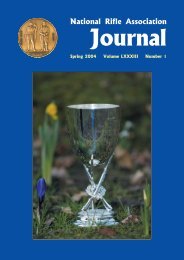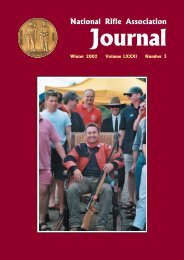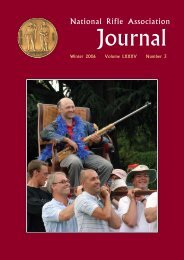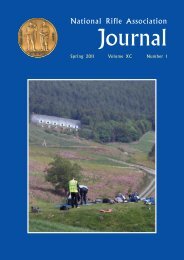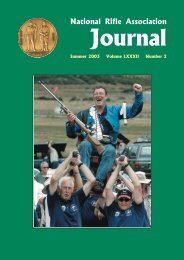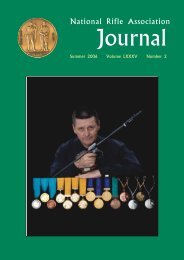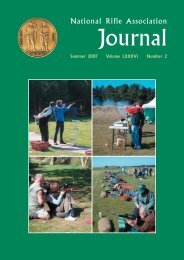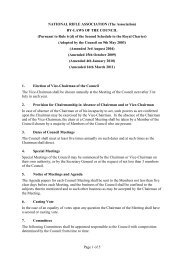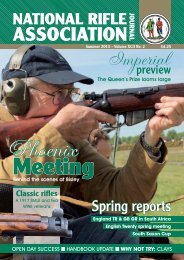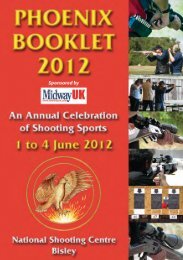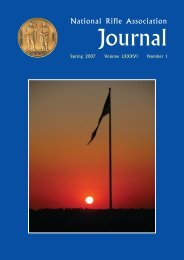The team's tour brochure. - National Rifle Association
The team's tour brochure. - National Rifle Association
The team's tour brochure. - National Rifle Association
You also want an ePaper? Increase the reach of your titles
YUMPU automatically turns print PDFs into web optimized ePapers that Google loves.
Smallbore shooting – good practice for Target <strong>Rifle</strong>?by Ian DavidsonAt first sight it may seem curious to have an article discussing small-bore target shooting in the<strong>brochure</strong> of an NRA Target <strong>Rifle</strong> <strong>tour</strong>ing team.Well maybe not so strange; the Channel Islands<strong>tour</strong> takes place in May, early in the Target <strong>Rifle</strong> year, before many of us have had muchopportunity for practice after the winter and what is, for most of us, a long break from Target<strong>Rifle</strong> shooting.<strong>The</strong> problem therefore is how to stay in practice, remain sharp and be matchready for some serious competition early in the Target <strong>Rifle</strong> year.a wide range of small-bore prone matches and not simply short range indoor shooting, althoughthe latter will undoubtedly be the main source of winter practice in the UK. I'm in no doubtthat to maximise the benefit and pleasure of small-bore rifle, it is essential to experience thejoys of outdoor shooting at 50m and 100 yards too.Without doubt there are some significant differences between Target <strong>Rifle</strong> and small-bore rifleshooting, and these have been comprehensively examined in a paper by Tim Elliott entitled‘Differences between small-bore and full-bore prone Target <strong>Rifle</strong> shooting’. It is an excellentread and I recommend it to you *.<strong>The</strong>re are also great areas of overlap such as building a stableand effective prone position, breathing control, obtaining the correct sight picture, triggercontrol, and the process of taking the shot where fundamental lessons learned for one disciplinecan be readily applied to the other.<strong>The</strong>se skills are key to both aspects of our sport, so thatwinter practice on the small-bore range can reinforce good practice forTarget <strong>Rifle</strong> and you canhit the ground running when the spring arrives.In this article, I don’t propose to revisit whatTim has already covered so well, but rather to focuson a few differences between small-bore rifle andTarget <strong>Rifle</strong> which may be considered to makemixing the two more difficult, and how they may be overcome and even used to advantage.Shooting at Fort Le Marchant, Guernsey on a glorious May day (mustn’t damage theNapoleonic fort).SCATT is an excellent device designed to enable the shooter to develop and improve his or hertechnique in a controlled and measurable way, with the added advantage of being able to remainin practice during the winter months. An increasing number of rifle shooters are becomingfamiliar with the SCATT trainer, and an article specifically about SCATT appears elsewhere inthis <strong>brochure</strong>. However, SCATT is expensive and only a limited number of individuals and clubscurrently have them. It also doesn’t facilitate the competitive environment that can sometimesmodify our performance.It is my belief that the best way for the Target <strong>Rifle</strong> shooter to develop technique and remainin winter practice lies in a combination of dry firing with a device such as SCATT and live firing– and what better way to experience year-round live firing than with the small-bore rifle. I mustbe clear at this point that when I talk about small-bore target rifle shooting, I'm thinking aboutSight adjustmentAn obvious problem is that full-bore and modern small-bore target rifles (the well-knownGerman makes for example) are fitted with sights that adjust for windage and elevation inopposite senses. For the shooter who aims to be competitive in both disciplines, this isundoubtedly a significant difference that brings the very real chance of winding the wheels thewrong way, particularly when under pressure and making rapid adjustments in fluctuating windconditions.This would clearly be disastrous.<strong>The</strong> problem is compounded by the fact that small-bore rifle sights aren’t even consistent; BSA’sadjust in the same sense as Target <strong>Rifle</strong>s, whilst German rifles wind the other way.<strong>The</strong>n thereis the size of the click adjustment; most Target <strong>Rifle</strong> and BSA sights have quarter minute clicks,whilst Anschütz etc generally use one sixth minute adjustments. It just gets worse and worse.For this reason some shooters who wish to be proficient in both small-bore and full-bore havedoggedly held on to their trusty BSA International, so that their sights will all adjust in the sameway with consistent click size. This is a perfectly acceptable solution to the sight problem,although it rather limits the choice of small-bore rifle, and introduces a new potential issue –BSAs come with single stage triggers.<strong>The</strong>re is no easy answer to this one, but my response is ‘vive la différence’! My Anschütz andmy Musgrave are sufficiently different that I'm never in doubt which one I'm shooting. If I were



